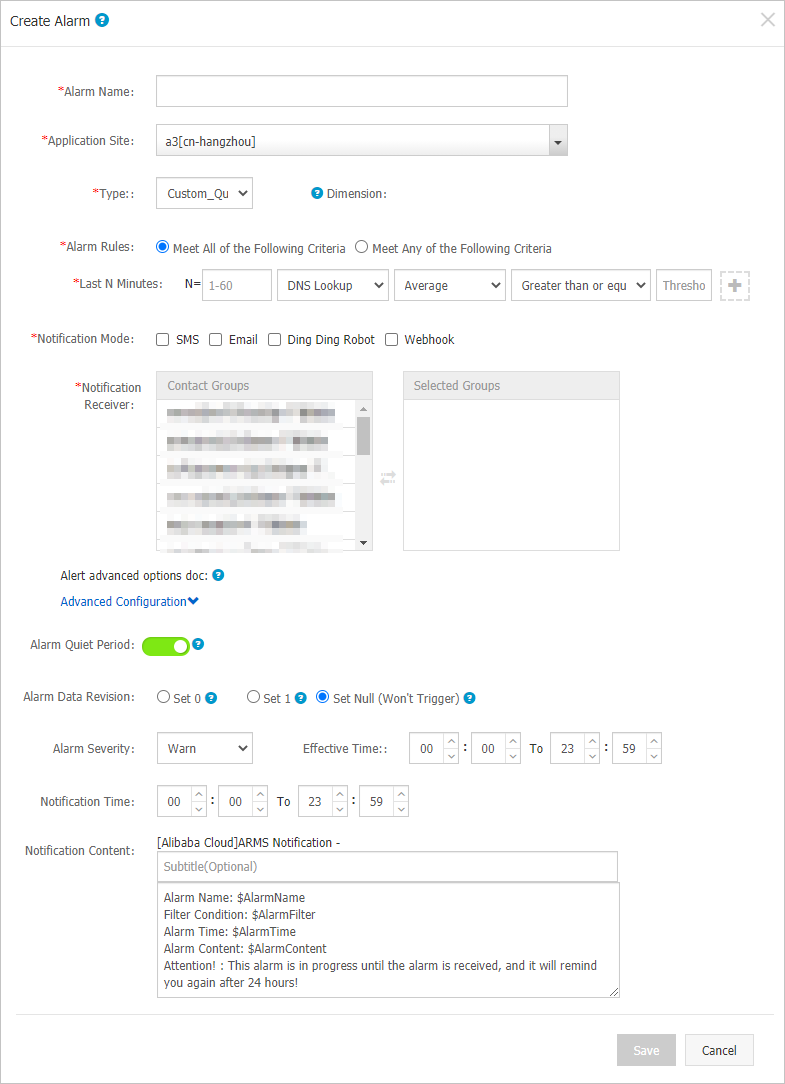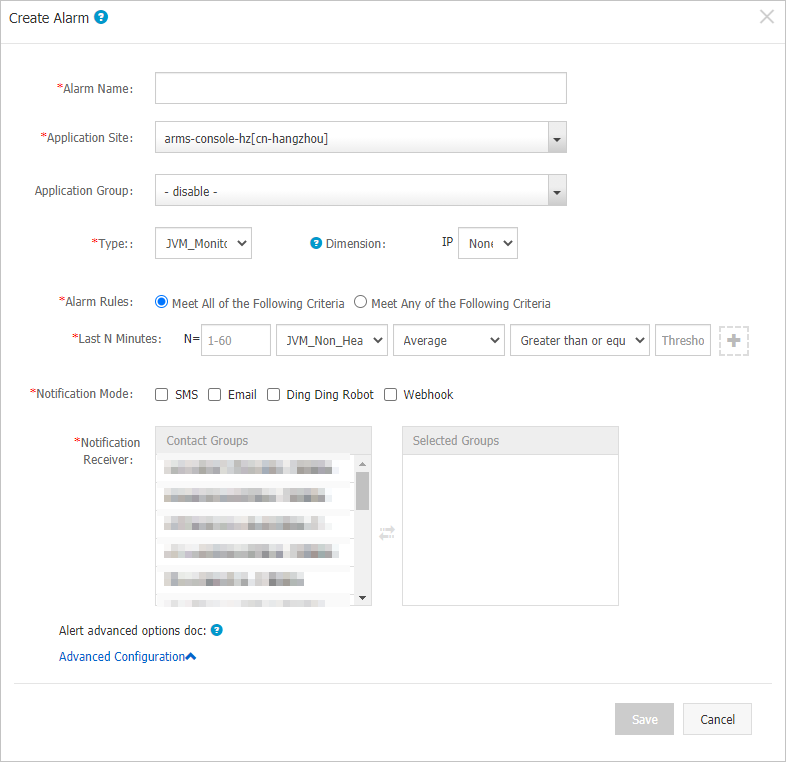You can create alerts to set alert rules for specific monitored objects. If a rule is triggered, the system sends an alert notification to the specified alert group in the specified alerting mode. This allows you to take necessary actions to solve the problem.
Prerequisites
- Contacts are created. Only contact groups can be set as the notification receiver of an alert.
Background information
Default behaviors of alert notifications:
- To prevent you from receiving a large number of alert notifications in a short period of time, the system sends only one message for the same alert within 24 hours.
- If no alerts are generated for the same issue within 5 minutes, the system sends a recovery email to notify you that the alert has been cleared.
- After a recovery email is sent, the alert status is reset. If this alert is triggered again, it is considered as a new alert.
An alert widget is essentially a data display method for datasets. When you create an alert widget, a dataset is created to store the underlying data of the alert widget.
Create an alert
To create an alert for an application monitoring job on Java Virtual Machine-Garbage Collection (JVM-GC) times in period-over-period comparison, perform the following steps:
Description of basic fields
The following table describes the basic fields in the Create Alarm dialog box.

| Field | Description | Setting |
|---|---|---|
| Application Site | The monitoring job that is created. | Select a value from the drop-down list. |
| Dimension | The dimension for alert metrics (datasets). You can select None, =, or Traverse. |
|
| Last N Minutes | The system checks whether the data results in the last N minutes meet the trigger condition. | Value range: 1 to 60. |
| Notification Mode | Emails, SMS messages, DingTalk Chatbot, and Webhook are supported. | You can select multiple modes. For more information about how to configure a DingTalk chatbot to send alert notifications, see . |
| Alarm Quiet Period | You can enable or disable Alarm Quiet Period. By default, it is enabled. |
|
| Alarm Severity | Valid values include Warn, Error, and Fatal. | N/A |
| Notification Time | The time when the alert is sent. No alert notifications are sent outside of this time range, but alert events are recorded. | For more information about alert event records, see . |
| Notification Content | The custom content of the alert. | You can edit the default template. In the template, the four variables, $AlarmName, $AlarmFilter, $AlarmTime, and $AlarmContent, are preset. The rest of the content can be customized. Other preset variables are not supported. |
Description of complex general fields: period-over-period comparison
- N-minute-on-N-minute comparison: Assume that β is the data in the last N minutes, and α is the data generated between the Nth minute and the 2Nth minute. The N-minute-on-N-minute comparison is the percentage increase or decrease when β is compared with α. β can be an average, a sum, maximum, or minimum.
- N-minute-on-N-minute hourly comparison: Assume that β is the data in the last N minutes, and α is the data generated during the last N minutes in the previous hour. The N-minute-on-N-minute hourly comparison is the percentage increase or decrease when β is compared with α. β can be an average, a sum, maximum, or minimum.
- N-minute-on-N-minute daily comparison: Assume that β is the data in the last N minutes, and α is the data generated during the last N minutes at the same time on the previous day. The N-minute-on-N-minute daily comparison is the percentage increase or decrease when β is compared with α. β can be an average, a sum, maximum, or minimum.
Description of complex general fields: Alarm Data Revision
You can set Alarm Data Revision to Set 0, Set 1, or Set Null (Won't Trigger). This feature is used to fix anomalies in data, including no data, abnormal composite metrics, and abnormal period-over-period comparisons.
- Set 0: fixes the value that is checked to 0.
- Set 1: fixes the value that is checked to 1.
- Set Null (Won't Trigger): does not trigger the alert.
Scenarios:
- Anomaly 1: no data
User A wants to use the alerting feature to monitor page views. When User A creates an alert, User A selects Browser Monitoring Alarm. User A sets the alert rule: N is 5 and the sum of page views is at most 10. If the page is not accessed, no data is reported and no alert notification is sent. To solve this problem, you can select Set 0 for Alarm Data Revision. If you do not receive data, this is considered that zero data is received. This meets the alert rule and an alert is sent.
- Anomaly 2: abnormal composite metrics
User B wants to use the alerting feature to monitor the real-time unit price of a product. When User B creates an alert, User B selects Custom Monitoring Alarm. User B sets the dataset of variable A to the current total price, and the dataset of variable B to the current total number of items. User B also sets the alert rule: N is 3 and the minimum value of the current total price divided by current total items is at most 10. If the current total number of items is 0 and the value of the composite metric does not exist, no alert is sent. The value of the composite metric is the current total price divided by the current total number of items. To solve this problem, you can select Set 0 for Alarm Data Revision. The value of the composite metric, which is the current total price divided by the current total number of items, is considered to be 0. This meets the alert rule and an alert is sent.
- Anomaly 3: abnormal period-over-period comparisons
User C wants to use the alerting feature to monitor the CPU utilization of a node machine. When User C creates an alert, User C selects Application Monitoring Alarm, and sets the alert rule: N is 3 and the average CPU utilization of the node machine decreases by 100% compared with the previous monitoring period. If the CPU of the user fails to work in the last N minutes, α cannot be obtained. This means that the period-over-period comparison result does not exist. No alert is sent. To solve this problem, you can select Set 1 for Alarm Data Revision, and consider the period-over-period comparison result as a decrease of 100%. This meets the alert rule and an alert is sent.
What to do next
You can query and delete alert records in alert management.
